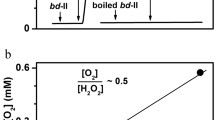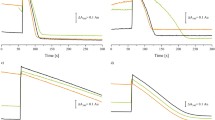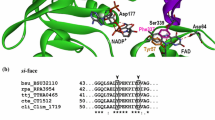Summary
The glutathione reductase from E. coli was rapidly inactivated following aerobic incubation of the pure and cell-free extract enzymes with NADPH, NADH and other reductants. The inactivation of the pure enzyme depended on the time and temperature of incubation (t1/2 = 2 min at 37°C), and was proportional to the |INADPH|/|enzyme| ratio, reaching 50% in the presence of 0.3 μM NADPH and 45 μM NADH respectively, at a subunit concentration of 20 nM. Higher pyridine nucleotide concentrations were required to inactivate the enzyme from cell-free extracts. Two apparent pKa, corresponding to pH 5.8 and 7.3, were determined for the redox inactivation. The enzyme remained inactive even after eliminating the excess NADPH by gel chromatography.
E. coli glutathione reductase was protected by oxidized and reduced glutathione against redox inactivation with both pure and cell-free extract enzymes. Ferricyanide and dithiothreitol protected only the pure enzyme, while NADP+ exclusively protected the cell-free extract enzyme. The inactive glutathione reductase was reactivated by treatment with oxidized and reduced glutathione, ferricyanide, and dithiothreitol in a time-and temperature-dependent process. The oxidized form of glutathione was more efficient and specific than the reduced form in the protection and reactivation of the pure enzyme.
The molecular weight of the redox-inactivated E. coli glutathione reductase was similar to that of the dimeric native enzyme, ruling out aggregation as a possible cause of inactivation. A tentative model is discussed for the redox inactivation, involving the formation of an ‘erroneous’ disulfide bridge at the glutathione-binding site.
Similar content being viewed by others
References
Monod J, Changeux J-P, Jacob F: Allosteric proteins and cellular control systems. J Mol Biol 6:306–329, 1963.
Holzer H, Duntze W: Metabolic regulation by chemical modification of enzymes. Ann Rev Biochem 40:345–374, 1971.
Krebs EG, Beavo JA: Phosphorylation-dephosphorylation of enzymes. Ann Rev Biochem 48:923–959, 1979.
Chock PB, Rhee SG, Stadtman ER: Interconvertible enzyme cascades in cellular regulation. Ann Rev Biochem 49:813–843, 1980.
Pekala PH, Anderson BM: Non-oxidation-reduction reactions of pyridine nucleotides. In J Everse, B Anderson, K-S You (eds). The Pyridine Nucleotide Coenzymes. Academic Press, New York, 1982, pp 325–377.
Grisolia S: The catalytic environment and its biological implications. Physiol Rev 44:657–712, 1964.
Herrera J, Paneque A, Maldonado JM, Barea JL, Losada M: Regulation by ammonia of nitrate reductase synthesis and activity in Chlamydomonas reinhardi. Biochem Biophys Res Common 48:996–1003, 1972.
Losada M: Interconversion of nitrate and nitrite reductase of the assimilatory type. In EH Fischer, EG Krebs, H Neurath, ER Stadtman (eds). Metabolic Interconversion of Enzymes. Springer, Berlin, 1974, pp 257–270.
Guerrero MG, Vega JM, Losada M: The assimilatory nitrate reducing system and its regulation. Ann Rev Plant Physiol 32:169–204, 1981.
Vega JM, Greembaum P, Garrett RH: Studies on the in vitro inactivation of the Neurospora crassa assimilatory nitrite reductase in the presence of reduced pyridine nucleotides plus flavin. Biochim Biophys Acta 377:251–257, 1975.
Chaparro A, De la Rosa MA, Vega JM: Involvement of oxygen in Chlorella fusca nitrate reductase inactivation by reduced nicotinamide adenine dinucleotide. Z Pflanzenphysiol 95:77–85, 1979.
De la Rosa MA, Gómez-Moreno C, Vega JM: Interconversion of nitrate reductase from Ankistrodesmus braunii related to redox changes. Biochim Biophys Acta 662:77–85, 1981.
Holmgreen A: Pyridine-nucleotide-disulfide oxidorreductases. In J Jeffrey (ed). Experientia Supplementum vol 36, Dehydrogenases Requiring Nicotinamide Coenzymes. Birkhauser, Basel, 1980, pp. 149–180.
Meister A, Anderson MA: Glutathione. Ann Rev Biochem 52:711–760, 1983.
Williams CHJr: Flavin-dependent dehydrogenases and oxidases. In PD Boyer (ed). The enzymes vol XIII, Academic Press, New York, 1976, pp. 89–173.
Loos H, Roos D, Weening R, Houwerzijl J: Familial deficiency of glutathione reductase in human blood cells. Blood 48:53–62, 1976.
Roos D, Weening RS, Loos JA: The protective role of glutathione. In F Guettler, JWT Seakins, RA Harkness (eds). Inborn Errors of Immunity and Phagocytosis. University Park Press, Baltimore, 1979, pp 261–286.
Mata AM, Pinto MC, López-Barea J: Purification by affinity chromatography of glutathione reductase (EC 1.6.4.2) from Escherichia coli and characterization of such enzyme. Z Naturforsch 39c:908–915, 1984.
Thieme R, Pai EF, Schirmer RH, Schulz GE: Three-demensional structure of glutathione reductase at 2 Å resolution. J Mol Biol 152:763–782, 1981.
Krauth-Siegel RL, Blatterspiel R, Saleh M, Schiltz E, Schirmer RH, Untücht-Grau R: Glutathione reductase from human erythrocytes. The sequence of the NADPH domain and of the interface domain. Eur J Biochem 121:259–267, 1982.
Pai EF, Schulz GE: The catalytic mechanism of glutathione red uctase as derived from X-ray diffraction analysis of reaction intermediates. J Biol Chem 258:1752–1757, 1983.
López-Barea J, Lee C-Y: Mouse-liver glutathione reductase. Purification, kinetics and regulation. Eur J Biochem 98:487–499, 1979.
López-Barea J: Mouse-liver glutathione reductase: inactivation by NADPH of two allelic variants. Rev Esp Fisiol 37:249–254, 1981.
Pinto MC, Mata AM, López-Barea J: Reversible inactivation of Saccharomyces cerevisae glutathione reductase under reducing conditions. Arch Biochem Biophys 228:1–12, 1984.
Pinto MC: Mecanismo de interconversión redox de la glutatión reductasa de Saccharomyces cerevisiae. Ph D Dissertation, Universidad de Extremadura, Badajoz, España, 1983, pp 1–212.
Pinto MC, Mata AM, López-Barea J: Evolución del espectro de la glutatión reductasa de levaduras durante su interconversión redox (Abstract). II Congr. Luso-Español Bioquim. pp 63, 1983.
López-Barea J, Pinto MC, Mata AM: Glutathione reductase redox interconversion (Abstract). XVth FEBS Meeting, pp 182, 1983.
Pesce A, Fondy TP, Stolzenbach F, Castillo F, Kaplan NO: The comparative enzymology of lactic dehydrogenases. J Biol Chem 242:2151–2167, 1967.
Lowry OH, Rosebrough MJ, Farr AL, Randall RJ: Protein measurements with the Folin-phenol reagent. J Biol Chem 193:265–275, 1951.
Brodelius P, Larsson P-O, Mosbach K: The synthesis of three AMP-analogues and their application as general ligands in biospecific affinity chromatography. EurJ Biochem 47:81–89, 1974.
Marusyk R, Sergeant A: A simple method for dialysis of small-volume samples. Anal Biochem 105:403–404, 1980.
Davis BJ: Disc electrophoresis II. Method and application to human serum proteins. Ann NY Acad Sci 121:404–427, 1964.
Reisner AH, Nemes P, Bucholtz C: The use of Coomassie brilliant blue G-250-perchloric acid solution for staining in electrophoresis and isoelectric focusing in polyacrylamide gels. Anal Biochem 64:509–516, 1975.
Andrews P: The gel-filtration behaviour of proteins related to their molecular weights over a wide range. Biochem J 96:595–606, 1965.
Akerboom TPM, Sies H: Assay of glutathione, glutathione disulfide and glutathione mixed disulfides in biological samples. Methods Enzymol 77:373–382, 1981.
Moreno CG, Aparicio PJ, Palacian E, Losada M: Interconversion of the active and inactive forms of Chlorella nitrate reductase. FEBS Lett 26:11–14, 1972.
Omachi A, Scott CB, Hegarty H: Pyridine nucleotides in human erythrocytes in different metabolic states. Biochim Biophys Acta 184:139–147, 1969.
Arscott LD, Thorpe C, Williams CHJr: Glutathione reductase from yeast. Differential reactivity of the nascent thiols in the two-electron reduced enzyme and properties of a mono-alkylated derivative. Biochemistry 20:1513–1520, 1981.
De la Rosa FF, Castillo F, Palacian E: Effects of denaturing agents on spinach nitrate reductase. Phytochemistry 16:875–879, 1977.
Barea JL, Sosa FM, Ortega T: Regulación de la NADH-nitrato reductasa de Chlamydomonas reinhardi. inactivación reversible in vivo e in vitro. Ann Edafol Agrobiol 33:1045–1054, 1974.
Worthington DJ, Rosemeyer MA: Glutathione reductase from human erythrocytes. Catalytic properties and aggregation. Eur J Biochem 67:231–238, 1976.
Worthington DJ, Rosemeyer MA: Human glutathione reductase: purification of the crystalline enzyme from erythrocytes. Eur J Biochem 48:167–177, 1974.
Jocelyn PC: Biochemistry of the SH Group. Academic Press, New York, 1972, pp 1–403.
Dubler RE, Anderson BM: Simultaneous inactivation of the catalytic activities of yeast glutathione reductase by N-alkylmaleimides. Biochim Biophys Acta 659:70–85, 1981.
Mata AM: Glutatión reductasa de Escherichia coli. Estudio de su interconversion redox in vitro e in vivo. Ph D Dissertation, Universidad de Extremadura, Badajoz, España, 1983, pp 1–203.
Mata AM, Pinto MC, López-Barea J: Interconversión redox de la glutatión reductasa de E. coli. Estudios in vitro e in vivo (Abstract). II Congr Luso-Español Bioquim pp 117, 1983.
Author information
Authors and Affiliations
Rights and permissions
About this article
Cite this article
Mata, A.M., Pinto, M.C. & López-Barea, J. Redox interconversion of glutathione reductase from Escherichia coli. A study with pure enzyme and cell-free extracts. Mol Cell Biochem 67, 65–76 (1985). https://doi.org/10.1007/BF00220987
Received:
Issue Date:
DOI: https://doi.org/10.1007/BF00220987




